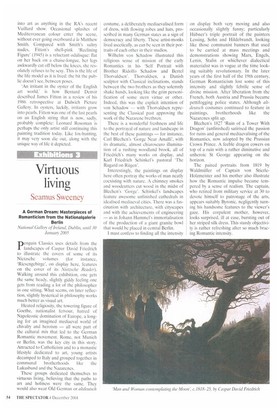Virtuous living
Seamus Sweeney
A German Dream: Masterpieces of Romanticism from the Nationalgalerie Berlin National Gallery °prelatic!, Dublin, until 30 January 2005
penguin Classics uses details from the 1 landscapes of Caspar David Friedrich to illustrate the covers of some of its Nietzsche volumes (for instance, `Riesengebirge', on display here, features on the cover of its Nietzsche Reader). Walking around this exhibition, one gets the same heady, slightly giddy feeling one gets from reading a lot of the philosopher in one sitting. What seems, on later reflection, slightly hysterical in philosophy works much better as visual art.
Heated religiosity, the towering figure of Goethe, nationalist fervour, hatred of Napoleonic domination of Europe, a longing for an imagined mediaeval world of chivalry and heroism — all were part of the cultural mix that led to the German Romantic movement. Rome, not Munich or Berlin, was the key city in this story. Attracted to Catholicism and to a monastic lifestyle dedicated to art, young artists decamped to Italy and grouped together in communal brotherhoods like the Lukasbund and the Nazarenes.
These groups dedicated themselves to virtuous living, believing that the paths to art and holiness were the same. They would also wear Old German or altdeutsch
costume, a deliberately mediaevalised form of dress, with flowing robes and hats, proscribed in many German states as a sign of democracy and liberty. These artist-monks lived ascetically, as can be seen in their portraits of each other in their studios.
Wilhelm von Schadow illustrated this religious sense of mission of the early Romantics in his 'Self Portrait with Brother Ridolfo Schadow and Bertel Thorvaldsen'. Thorvaldsen, a Danish sculptor with Classical inclinations, stands between the two brothers as they solemnly shake hands, looking like the grim personification of some stern virtue or other. Indeed, this was the explicit intention of von Schadow — with Thorvaldsen representing the Classical past approving the work of the Nazarene brethren.
There is a wonderful freshness and life to the portrayal of nature and landscape in the best of these paintings — for instance, Carl Blechen's 'Gorge Near Amalfi', with its dramatic, almost chiaroscuro illumination of a rushing woodland brook, all of Friedrich's many works on display, and Karl Friedrich Schinkel's pastoral 'The Rugard on Riigen'.
Interestingly, the paintings on display here often portray the works of man neatly coexisting with nature. A chimney smokes and woodcutters cut wood in the midst of Blechen's 'Gorge'. Schinkers landscapes feature awesome unfinished cathedrals in idealised mediaeval cities. There was a fascination with architecture, with cityscapes and with the achievements of engineering — as in Johann Hummel's immortalisation of the production of a giant granite bowl that would be placed in central Berlin.
I must confess to finding all the intensity
on display both very moving and also occasionally slightly funny; particularly Hubner's triple portrait of the painters Lessing. Sohn and Hildebrandt, looking like those communist banners that used to be carried at mass meetings and demonstrations showing Marx, Engels, Lenin, Stalin or whichever dialectical materialist was in vogue at the time looking suitably revolutionary. In the later years of the first half of the 19th century, German Romanticism lost some of this intensity and slightly febrile sense of divine mission. After liberation from the French, both Austria and Prussia became pettifogging police states. Although altdeutsch costumes continued to feature in paintings, brotherhoods like the Nazarenes split up.
Blechen's 1827 'Ruin of a Tower With Dragon' (unfinished) satirised the passion for ruins and general mediaevalising of the Romantics, now adopted by the Prussian Crown Prince. A feeble dragon cowers on top of a ruin with a rather diminutive and unheroic St George appearing on the horizon.
The paired portraits from 1819 by Waldmtiller of Captain von StierleHolzmeister and his mother also illustrate how the Romantic impulse became tempered by a sense of realism. The captain, who retired from military service at 30 to devote himself to patronage of the arts, appears suitably Byronic, negligently turning his handsome features to the viewer's gaze. His corpulent mother, however, looks surprised, ill at ease, bursting out of her striped silk dress. This sturdy objectivity is rather refreshing after so much bracing Romantic intensity.


















































































 Previous page
Previous page